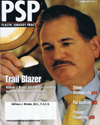William J. Binder, MD, FACS—pushing facial aesthetics into the future
PSP Plastic Surgery Practice – January, 2011
Beverly Hills facial plastic surgeon, Dr. William J. Binder is known worldwide for pioneering the use of alloplastic facial implants to enhance chins, cheeks and add facial volume to balance out facial structure and enhance youthfulness and beauty. The process is known as “facial contouring” and is now used by plastic surgeons across the globe. But Dr. Binder’s innovative spirit extends further and deeper than the anatomically accurate implants that he designed himself using CAD/CAM engineering software and 3-D computer modeling. Binder also made headlines in the early 1990’s for discovering that the wrinkle treating toxin Botox was also effective for treating migraine headaches which this past October (2010) was approved by the FDA for this purpose.
Dr. Binder holds more than 10 US and worldwide patents for medical devices and pharmaceuticals including the ground-breaking submalar implant, the first implant to successfully address facial volume loss due to aging and disease. Binder is currently taking facial implant technology and practice to the next level with a system that combines computer-based imaging with a CT scan and surface imaging that will allow plastic surgeons to custom-design implants for each individual patient and predict the aesthetic outcome preoperatively.
Since it represents about 65% of his practice, it’s not surprising that Dr. Binder has also been changing the way rhinoplasty and revision rhinoplasty is performed. While most surgeons were abandoning the closed rhinoplasty techniques for the simpler open approach, Dr. Binder was developing a hybrid technique dubbed “structure rhinoplasty” that selectively utilized the closed or open techniques or even combined them both to best address each individual rhinoplasty case. This versatile technique allows the flexibility to effectively address cases that would not fare well using one or the other approach exclusively, and when combined, can produce outcomes that are often superior to either technique alone.

